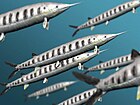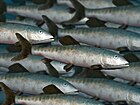Thrissops
| Thrissops Temporal range:
| |
|---|---|

| |
| Thrissops formosus | |
| Scientific classification | |
| Domain: | Eukaryota |
| Kingdom: | Animalia |
| Phylum: | Chordata |
| Class: | Actinopterygii |
| Order: | †Ichthyodectiformes |
| Genus: | †Thrissops Agassiz, 1833 |
Thrissops (from Greek: θρῐ́ξ thrix, 'hair' and Greek: ὄψις ópsis 'look')[1] is an extinct genus of stem-teleost fish from the Jurassic period (Kimmeridgian to Tithonian).[2] Its fossils are known from the Solnhofen Limestone,[3] as well as the Kimmeridge Clay.
Thrissops was a fast predatory fish about 60 centimetres (24 in) long, that fed on other bony fish.[4] It had a streamlined body with a deeply cleft tail and only very small pelvic fins. Thrissops was one of the smaller members of the order Ichthyodectiformes, which also included giants like Xiphactinus and Saurodon.[5]
References[edit]
- ^ Roberts, George (1839). An etymological and explanatory dictionary of the terms and language of geology. London: Longman, Orme, Brown, Green, & Longmans. p. 171. Retrieved 31 December 2021.
- ^ Cavin, Lionel; Piuz, André; Ferrante, Christophe; Guinot, Guillaume (2021-06-03). "Giant Mesozoic coelacanths (Osteichthyes, Actinistia) reveal high body size disparity decoupled from taxic diversity". Scientific Reports. 11 (1): 11812. Bibcode:2021NatSR..1111812C. doi:10.1038/s41598-021-90962-5. ISSN 2045-2322. PMC 8175595. PMID 34083600.
- ^ Solnhofen und seine Fossilien: Thrissops Archived 2010-04-29 at the Wayback Machine
- ^ Orvar Nybelin, "Versuch einer taxonomischen revision der jurassischen Fischgattung Thrissops Agassiz", Nature (1964)
- ^ Palmer, D., ed. (1999). The Marshall Illustrated Encyclopedia of Dinosaurs and Prehistoric Animals. London: Marshall Editions. p. 39. ISBN 1-84028-152-9.







